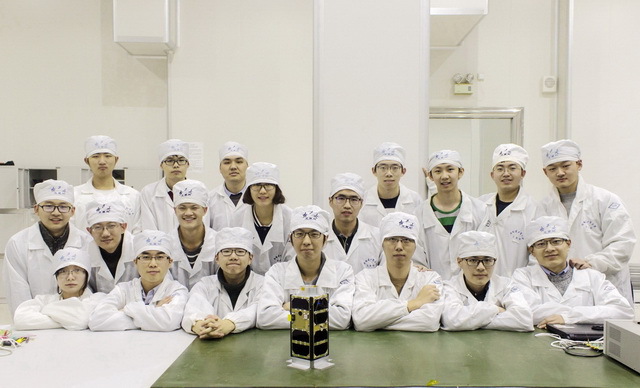Reported by: Ji Xing
Translated by: Sun Jiayue
Edited by: Garrick Jones
Date:2017-4-19
At 23:11 on April 18, the second satellite ( Lilac-1 ) developed by our student's Micro nano satellite team, together with the other 27 cube satellites in the international QB50 project, was loaded in the "Cygnus" cargo spacecraft-"John Glenn" and shipped as a regular cargo to the International Space Station.
"Lilac-1" is a scientific test cube satellite, it weighs nearly 2 kg and adheres to the standard 2U structure. The satellites are equipped with 3 effective payloads: ion and neutral mass spectrometer, amateur radio transponder and low resolution CMOS camera for atmospheric low heat layer composition research, amateur radio communication and space photography tasks. It is reported that the spacecraft will be docked with the International Space Station on April 22. After 3 months, the "Lilac 1" will be released into the track by the mechanical arms in the space station.
Different from the previous small satellites "test-1", "test-3", "Kuaizhou-1", "Kuaizhou-2", "Jilin-1 optical A star" and other small satellites developed by teachers, "Lilac-1", “Lilac-2 " and other nano-satellites developed by HIT are our innovation and exploration for fostering a new generation of interdisciplinary talents in the aerospace field. Through organizing the students’ micro-nano satellite research and development team, HIT supports students to design, develop, manage and control the satellite. Students can obtain great experience, while make a useful contribution to building a world-class university.
More than 100 undergraduates, master's and doctoral students in nine disciplines(aerospace, mechanics, computer, control, machinery, communication, electrical, thermal, chemical )of HIT have participated in the design, research and development of the satellite. It’s a cross disciplinary team. There are altogether 13 outstanding students who are taking part in the research and development of the "Lilac-1"(Wei Mingchuan, Yu Yang, Wu Fan, Feng Tianyu, Hu Chaoran, Zhang Jiyao, Yan Puti, Wu Tingcheng, Wang Cheng, Miao Yue, Qiu Shi, Gong Zhaopei and Han Yongbo).
On december 28, 2016, the satellite BY70-1 was launched in Taiyuan. The team was in charge of developing onboard devices and cameras, and providing comprehensive technical support for the follow - up ground monitoring and control. On January 16, 2017, HIT received a grateful letter from the China Aerospace Science and Technology International Exchange Center and the Beijing Bayi School. At present, the team is undertaking the design and development task of the third satellite-ASRTU nano satellite supported by the ASRTU.
Both individuals and the team as a whole have been awarded the "Xiaoping technological innovation team", "the first prize of the 14th Challenge Cup", "nomination award of the National Excellent College Students " and other honors. To ensure the sustainable development of the team, in the "double first-class" construction, HIT builds the country's first nano satellite development workshop for students, supports and encourages inside and outside students to innovate and practice on related devices, machine, parts, whole satellite and other different levels. On the initial stage, the workshop could only accommodate student innovation tasks for almost 40 people per year, and the follow-up plan will increase this number to 100 people per year.

Micro-nano satellite research and development team of HIT

"Lilac-1"


